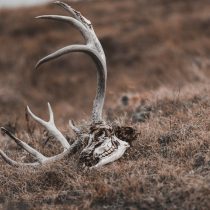
Dorothy had had a very hard life, one we wouldn’t wish anyone. Her mother was killed when she was very young, and she was taken away to sell to an amusement park in Cameroon. He spent 25 years of his life among chains, taunts, alcohol and tobacco. She was eventually rescued and taken to the Sanaga-Yong rescue center, and there she was able to make peace with the world. At last eight years calm, the suffering was over. These years served him to rebuild, form strong friendships and eventually become a figure respected and loved by his new community of chimpanzees.
Dorothy, a chimpanzee approaching age 50, died of cardiac arrest on September 23, 2008, but died among her loved ones. Monica Szczupider, a rescue center volunteer, immortalized that moment with a photograph that in 2009 would go around the world thanks to National Geographic.
The chimpanzees of that community huddled behind a metal fence, each protagonist of a terrible story with a bittersweet ending. They contemplated excitedly, hands on the shoulders of their companions, how the center’s caregivers forever took Dorothy’s lifeless body.
The success of that photograph was perhaps predictable. It was very easy to connect with the scene. A loved and respected individual was withdrawn forever, in the face of the helplessness of a society that watched with emotions in full bloom.
Watch out for anthropocentrism
The study of the reactions of other species to death is a specialty we call “comparative tanatology”, and has a very recent history. From Jane Goodall’s detailed and poignant descriptions, to current pilot proposals to study animal reactions to strange and unexpected situations, such as loudspeakers emitting the voice of dead elephants and animatronic heads.
Comparative tanatology is a field very focused on primates, and it is for several reasons that can be summed up in one: we are primates.
Death is of enormous importance to us, and if we are going to study how other species react to it, we are expected to focus on those that are as close as possible. This is due to a certain evolutionary parsimony, but also to a bias that deeply soaks our thinking: anthropocentrism, a kind of egocentrism extended to everything that reminds us of us.
In our recent article we advocate that there are two forms of anthropocentrism that have been in the way of the development of comparative tanatology. We have been wrong about the distorting effect of two prisms through which we observe the natural world: an intellectual and an emotional anthropocentrism.
Death is of maximum importance to each of us. The pain that accompanies the loss of a loved one is only comparable to the terror that awakens the absolute silence that awaits us all. The resulting fear has given rise to all kinds of beliefs to quell it, with which we feel strongly identified. Something so full of emotions, so human, is easily overestimable. Comparative tanatology has not been exempt from this bias.
We tend to over-intellectual death. That is probably why many authors regard this concept as unattainable for other species: either they understand it as us, or they do not at all.
This is joined by the way death fits into our peculiar WEIRD culture (Anglo-Saxon acronym for Western, educated, industrialized, rich and democratic societies), in which the dead are people who vanish from our lives and plans. This has led to theoretical proposals utterly lacking in perspective.
Some of the theoretical requirements that have been proposed as necessary to understand death are very high. Exorbitant. For example, the need for a theory of the mind (the ability to create mental models that represent the minds of other individuals) or a concept of absence. But death in nature is much simpler and much more common than it is for us. In our urbanite world we run the risk of forgetting that the dead are essentially broken bodies without arrangement.
This is something Susana Monsó defended by proposing the minimal concept of death. If we release our elaborate conception of death from all unnecessary burden, we there remains the essentials to understand it: bodies that stop behaving as they used to and lose their functions forever. Understanding this does not require privileged minds, and many species can probably achieve it, even if there are differences in the way they conceive it.
As we have already mentioned, death is not only important to humans, it is also often a tragedy. If we make the mistake of expecting other species to react like us to her, we fall into emotional anthropocentrism. This is one of the reasons why comparative tanatology has focused so much on primates, because they remind us not only of the physical and intellectual aspect, but also of their relationships.
Reactions to death can be very different from grief or bereavement (although there is good evidence of both in nature). The concept of death is compatible with a myriad of emotional reactions, and bereavement is just one of them.
Let’s think about predators and their relationship to death. Imagine the leopard that, after years of despondents, has learned to distinguish the exact moment when, after applying the lethal bite, its prey loses vital functions. In corpses not only fade forever the typical functions of life, but also new ones appear. A corpse is different from all the senses. This promotes learning in animals that can be life-based.
It’s not always easy to be a predator (lions are only 26% likely to catch a gazelle), and we know that success or failure depends heavily on that learning. Therefore, predators pay special attention to any clue that dams can provide. This attention is not only evidence of the ability to cater to functionality, it can also be the source of what could be an unknown evidence of the existence of the concept of death in predators.
Play dead!
Among evolutionary biologists, the suggestive idea that peacock males are shaped by the minds of females is often repeated. The preferences of the females have shaped, over the generations, the ostentatious tails of the males. Knowing the shape and behavior of the males we can know the minds of those peacock females.
With predators and some of their prey we might have a similar case.
We are referring to a relatively widespread phenomenon in the animal kingdom: so-called “tanatosis”. Many animals, when endangered, can be completely paralyzed (from spiders to sharks to chickens and humans). This sometimes saves their lives.
In some cases, as with death, not only does the movement disappear, new functions are also added, typical of corpses. It’s that similarity to the death to which tanatosis owes its name. In some species, mimicry with death is absolutely fantastic: they adopt a facial expression typical of a corpse and lower their body temperature. Some even expel blood from the mouth.
Species better suited to tanatosis have nothing to envy of the mimicry of a leaf-shaped insect and, like that insect, they need not have to have any knowledge of imitating something. More elaborate shapes are likely triggered automatically.
The importance of tanatosis arises when we wonder about the evolution of it, for it is the mind of predators that has shaped this imitation of death. Like the tail of the peacock, this defensive strategy opens a window into the minds of predators, their ability to understand death and what they expect from it.
Comparative tanatology is a very recent branch of science, and it probably still saves us many surprises. The true scientific interest in this branch of science began in 2010, just after the publication of that photograph in which chimpanzees at the Sanaga-Yong rescue center said goodbye to Dorothy.
This photograph was a huge revulsive for society and for the scientific community. I had everything you need to fit our intellectual and emotional anthropocentrism. Now is the time for comparative tanatology to free itself from those limitations and explore for itself a much richer and more complex world than anyone would have expected. Death is common in nature, and the concept of death also seems to be common.
Antonio José Osuna Mascaró, PhD Biologist and PhD student, University of Veterinary Medicine, Vienna and Susana Monsó, Postdoctoral Researcher in Animal Ethics and Animal Mind Philosophy, University of Veterinary Medicine, Vienna
This article was originally published in The Conversation. Read the original.





